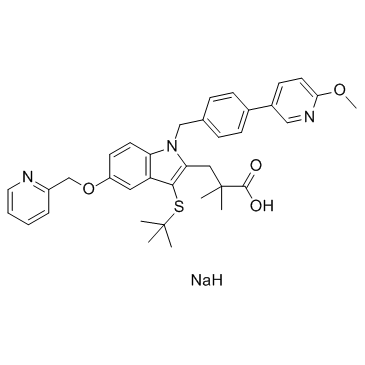1147872-22-7
| Name | sodium,3-[3-tert-butylsulfanyl-1-[[4-(6-methoxypyridin-3-yl)phenyl]methyl]-5-(pyridin-2-ylmethoxy)indol-2-yl]-2,2-dimethylpropanoate |
|---|---|
| Synonyms |
unii-fv4g3o3wi2
am-103 AM 103 |
| Description | AM 103 is a potent and selective FLAP inhibitor, with an IC50 value of 4.2 nM. |
|---|---|
| Related Catalog | |
| Target |
IC50: 4.2 nM (FLAP)[1] |
| In Vitro | AM 103 has an IC50 value of 349 nM in the human blood LTB4 inhibition assay. AM 103 has an excellent CYP profile against the 5 most common CYP isoforms with IC50 values greater than 30 μM for CYP2D6 and >50 μM for CYPs 3A4, 2C9 2C19, and 1A2[1]. AM103 is a novel, potent, and selective FLAP inhibitor with IC50 values of 350, 113, and 117 nM against human, rat, and mouse whole-blood ionophore-stimulated LTB4 production, respectively[2]. |
| In Vivo | AM 103 has high bioavailability (64%), low clearance (2.9 mL/min/kg), low volume of distribution (0.41 L/kg), and a long i.v. half-life (5.2 h) in dogs. AM 103 (10 mg/kg q.i.d.) inhibits the increase in CysLTs and EPO by approximately 60%, and IL-5 levels are reduced to the concentrations obtained following saline treatment alone in mice[1]. AM103 (1 mg/kg, p.o.) displays >50% inhibition for up to 6 h with a calculated EC50 of appr 60 nM, in a rat ex vivo whole-blood calcium ionophore-induced LTB4 assay. AM 103 inhibits LTB4 and cysteinyl leukotriene (CysLT) production with ED50 values of 0.8 and 1 mg/kg, respectively, when rat lung is challenged in vivo with calcium ionophore. In this model, the EC50 derived from plasma AM103 is appr 330 nM for inhibition of both LTB4 and CysLT. In a model of chronic lung inflammation using ovalbumin-primed and challenged BALB/c mice, AM103 reduces the concentrations of eosinophil peroxidase, CysLTs, and interleukin-5 in the bronchoalveolar lavage fluid. Finally, AM 103 increases survival time in mice exposed to a lethal intravenous injection of platelet-activating factor[2]. |
| Kinase Assay | Packed human polymorphonuclear cell pellets (1.8×109 cells) are resuspended, lysed, and 75,000g membranes. The 75,000g pelleted membranes are resuspended in a Tris buffer (50 mM Tris HCl, pH 7.4, 1 mM EDTA, 1 mM DTT, and 30% glycerol) to yield a protein concentration of appr 4 mg/mL. Then, 2.5 μg of membrane protein per well is added to 96-well deep well plates containing Tris-Tween buffer (100 mM Tris HCl, pH 7.4, 100 mM NaCl, 1 mM EDTA, 0.5 mM DTT, 5% glycerol, and 0.05% Tween-20) and appr 30,000 cpm of [3H]-3-[5-(pyrid-2-ylmethoxy)-3-tert-butylthio-1-benzyl-indol-2-yl]-2,2-dimethylpropionic acid and test compound in a total volume of 100 μL and incubated for 60 min at room temperature. The reactions are then harvested onto GF/B filter plates using a Brandel 96-tip harvester and washed 3× with 1 mL of ice-cold Tris-Tween buffer. The filter plates are dried, the bottoms sealed, and 100 μL of scintillant added. The plates are incubated for 1 h before reading on Perkin-Elmer TopCount. Specific binding is defined as total radioactive binding minus nonspecific binding in the presence of 10 μM MK886. IC50 values are determined using Graphpad prism analysis of drug titration curves. |
| Animal Admin | Compounds are administered intravenously (i.v.) (2 mg/kg) to two or three male rats (fasted overnight) as a solution in PEG400/ethanol/water (40/10/50, v/v/v) via a bolus injection into the jugular vein (2 mg/mL; 1 mL/kg) and orally (p.o.) (10 mg/kg) to two or three male rats as a suspension in 0.5% methylcellulose via an oral gavage to the stomach (3.33 mg/mL; 3 mL/kg). Blood samples (approximately 300 μL) are taken from each rat via the jugular vein cannula at time intervals up to 24 h postdose (8−9 samples per animal). After each sample, the cannula is flushed with an equivalent volume of heparinized saline (0.1 mL at 40 units/mL). Plasma samples, prepared by centrifugation of whole blood, are stored frozen (−80°C) prior to analysis. |
| References |
| Molecular Formula | C36H40N3NaO4S |
|---|---|
| Molecular Weight | 633.78 |
| PSA | 114.60000 |
| LogP | 6.94340 |
| Storage condition | 2-8℃ |
